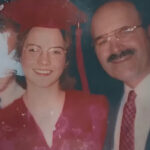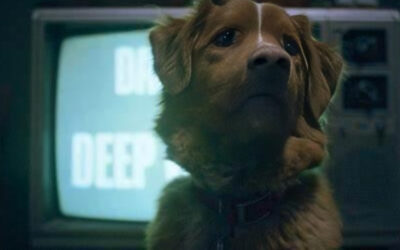You don’t get more prolific in the zombie genre than writer-director George A. Romero. When you hear the word zombie, his name comes to mind. Sadly, we lost Romero when he passed away on July 16, 2017. But July 16 left behind several projects, including the half-written novel The Living Dead.
Romero’s widow wanted to see the novel complete, so she reached out to best-selling novelist Daniel Kraus, the same author who co-wrote The Shape of Water with Guillermo del Toro. Now, after years of work, the novel is complete and soon to be released. I sat down with Kraus to talk about The Living Dead and the process of bringing George A. Romero’s final body of work to his fans and the world.
Kraus has a long record of delivering brilliant novels, including Trollhunters, adapted for the Netflix series, as well as Scowler, Rotters, and many more. He expressed how honored he was to co-write the novel, and I think he may be Romero’s biggest fan.
Horror Fuel: “Let me tell you, The Shape of Water is incredible. It’s a beautiful film set in a dingy, dirty setting, which I found surprising. How did that book and then the film come to be?”
Daniel Kraus: “Thank you. First of all, your comment about it being beautiful and dingy is something that I’ve always been interested in. Many of my books share that in common. The story of how the book and movie came to be is a long one. Still, the short version is that Guillermo del Toro and I were working together on Trollhunters – it was a book before it was adapted for the Netflix series. I told him about this idea I had for a Creature from the Black Lagoon-type story. He was fascinated by it. The short version is that two years later, the movie and the book were made. It’s been a wild trip.”
Horror Fuel: “For the record, I’m a big fan of Trollhunters.”
Daniel Kraus: “The book is quite a bit different. It was written originally for a slightly older audience. It’s a little more serious, a little more intense.”
Horror Fuel: “I will check it out.
Now, you are about to release your new book, The Living Dead, which was half-written by horror legend George A. Romero before his death. How did you become involved?”
Daniel Kraus: “He wrote like a third of it. But in addition to that, he left notes on where he was going with some of it. With that, I’d say it’s closer to half. The short version of that is that his wife and manager, shortly after his death, were reviewing some of his unfinished projects and trying to determine what to do with them. They knew of me and my books and that I’m a huge student of Romero. They called me up, which was completely out of the blue, but Romero is my favorite artist. It’s more than a dream come true. I didn’t even know that it was a possibility.”
Horror Fuel: “In your own words, a description of what the novel is about?”
Daniel Kraus: “It’s a giant book, so it’s hard to give a synopsis without talking about the characters. It’s Romero’s final word on zombies from the man who created the modern concept of the zombie, fifty years after he made Night of the Living Dead. It follows several groups of people for fifteen years, starting on the first day of the zombie apocalypse. It then covers the period during which he made the movies. His movies cover about six years of zombified America. The Living Dead covers that time and picks up with the last of Romero’s movies.”
Horror Fuel: “Awesome! The book is so thick. I love the cover; it looks like it’s aging, and the paint is chipping away.”
Daniel Kraus: “The hardcover is going to be thick, and some of those chips are going to be textured.”
Horror Fuel: “I couldn’t even imagine. In The Living Dead, several groups are the focus of the book. Why those characters?”
Daniel Kraus: “That’s a great question. Why choose these entry points, especially during a global catastrophe? It could be anyone. First of all, they are all centered in the United States. It was written enough by Romero to know that it would be specifically about America, which he’s always criticized. All of the main characters were there in George’s manuscript. I can’t say where those characters came from or why he chose them. I’m sure part of it was wanting a cross-section. We have leaders, those on the fringe of society, and everyone in between, all sorts. I don’t think he was interested in writing 200 characters, instead, he picked a handful on entry points for what he wanted to talk about.”
Horror Fuel: “It’s great that it is set up that way. It keeps the reader invested. ”
Danie Kraus: “That was the idea.”
Horror Fuel: “What is your favorite aspect of the novel?”
Daniel Kraus: “Let’s see… You know, I like the way that it is divided into different groups. There’s a fifth group, including the autistic woman who works at part of the census bureau; she becomes the records keeper of the downfall of humanity. Compared to the other groups, it’s the smallest by far, but this is largely due to how she operates, works, and expresses herself. I find those sections to be very nice palate cleansers compared to the other sections. There’s so much action. There is so much going on. There’s a quietness in the Hoffmann parts. She’s completely alone for all those years. It’s an interesting contrast. It’s like with the coronavirus, watching someone distancing themselves year after year, after year, until they are completely dislocated from society.”
Horror Fuel: “You have a great point. Her sections are very different from the rest of the chapters. With the pandemic happening around us, it is a perfect time to release this book.
Daniel Kraus: “It’s funny, the original publish date was set for June 9 and had June 9 pushed to August 4. On August 4, Volley got shoved out of the way by an actual virus. Hopefully, by the time this book does come out, the real world will resemble it less.”
Horror Fuel: “Hopefully. You know, the first time I saw people fighting over toilet paper during this pandemic, a horde of zombies was precisely what came to mind.
Speaking of zombies, how long have you been a fan of Romero’s and of zombies?”
Daniel Kraus: “Well, I guess most of my life. I’m more of a George Romero fan than a zombie fan. I like zombies. He was primarily known for his zombie movies, but he also directed many other films. I love those just as much. Night of the Living Dead is the first movie I remember seeing. I was maybe 5 or 6 years old. I was a 5-year-old zombie fan, I guess.”
Horror Fuel: “I understand. I started my love affair with horror when I was 9.
I have a feeling that The Living Dead will be adapted for film, especially since it was Romero’s last project. Am I right?”
Daniel Kraus: “That’s a fair question. I’m unable to provide any specific details at this time. There is some interest in it being Romero’s last word on zombies.”
Horror Fuel: “After I got a few chapters in, I knew it had to have one.”
Daniel Kraus: “Yeah, a movie has to start somewhere.”
Horror Fuel: “What’s the experience like being a best seller?”
Daniel Kraus: “It’s not like it affects the day-to-day. You’re still just writing. For me, I sit at the same table every day; it doesn’t matter how many copies I’m selling; it’s still the same story.”
Horror Fuel: “Can you tell us your process when writing a novel?”
Daniel Krause: “It’s uniform. It’s like a full-time job. I get up, get going, and grab some food. I work an eight-hour day, sometimes more. I work six days a week. It’s very normal. I think many people enjoy taking their laptops to a coffee shop every day when they are writing; it seems to energize them. I prefer just a normal home routine.”
Horror Fuel: “I know many writers have these little quirks, like putting posted notes with ideas everywhere or using a specific coffee cup. Do you have any quirks like that?”
Daniel Kraus: “They’re not so odd. Especially with a big project like this, I make giant outlines. They can be huge—the size of small books. I spend weeks, weeks doing that. I like to do some of the plotting work ahead of time. I do lots of preparations. I’ve got stacks of those.”
Horror Fuel: “Were there any challenges you faced while writing your and Romero’s novel?”
Daniel Kraus: “Well, when you finish anyone’s work, there are two challenges. He throws a bunch of baseballs up in the air, and then you’re supposed to catch them. We had notes on some of the things he was doing and some of the things he was thinking, but there were many things we didn’t have notes on. There are many fascinating things he begins and has no end.
For him specifically, the process involved figuring out what I could and then making the most intelligent choices about what I didn’t know. That required studying all his films, screenplays, interviews, and talking to people who knew him, as well as engaging in lengthy discussions with his wife, and then reading critical analyses of his work. Finally, I got from his wife a list of stuff that he liked, the movies he liked, the music that he wanted, and I studied that so that I could be inspired by what inspired him.”
Horror Fuel: “That sounds very intense, but you talk about it like a labor of love. So many people have been inspired by him, and I’m glad you are one of them.”
Horror Fuel: “Just out of curiosity, where would you go if you were ever caught in a zombie outbreak?”
Daniel Kraus: “Ideally, I think you would go to some island, at least for the short term. That’s in Romero’s final movie, Survival of the Dead. At the end of Day of the Dead, there’s also an idea that if we could get to an island, it would be okay. Of course, his last movie was set on an island. You want to get away from people. You don’t want to be cold, so you can’t go to the Arctic. You want to escape to a place with natural resources and food.”
Horror Fuel: “That sounds like a pretty good plan.”
What an honor it must have been to complete George A. Romero’s last word on zombies. Please visit his website to obtain a copy of The Living Dead, a 4-star, award-winning novel, which will be released on August 4. You can pre-order your copy of The Living Dead now.














